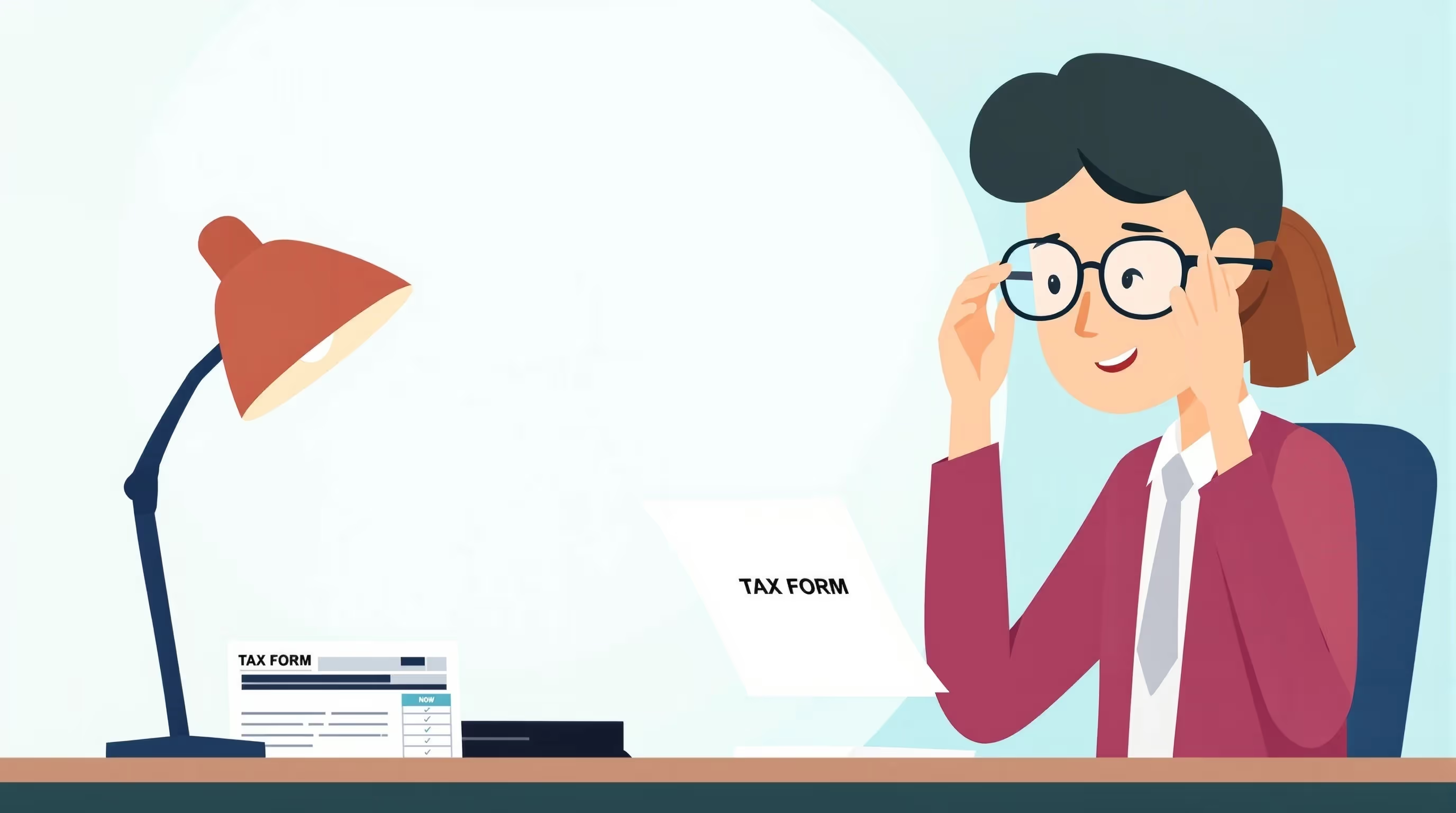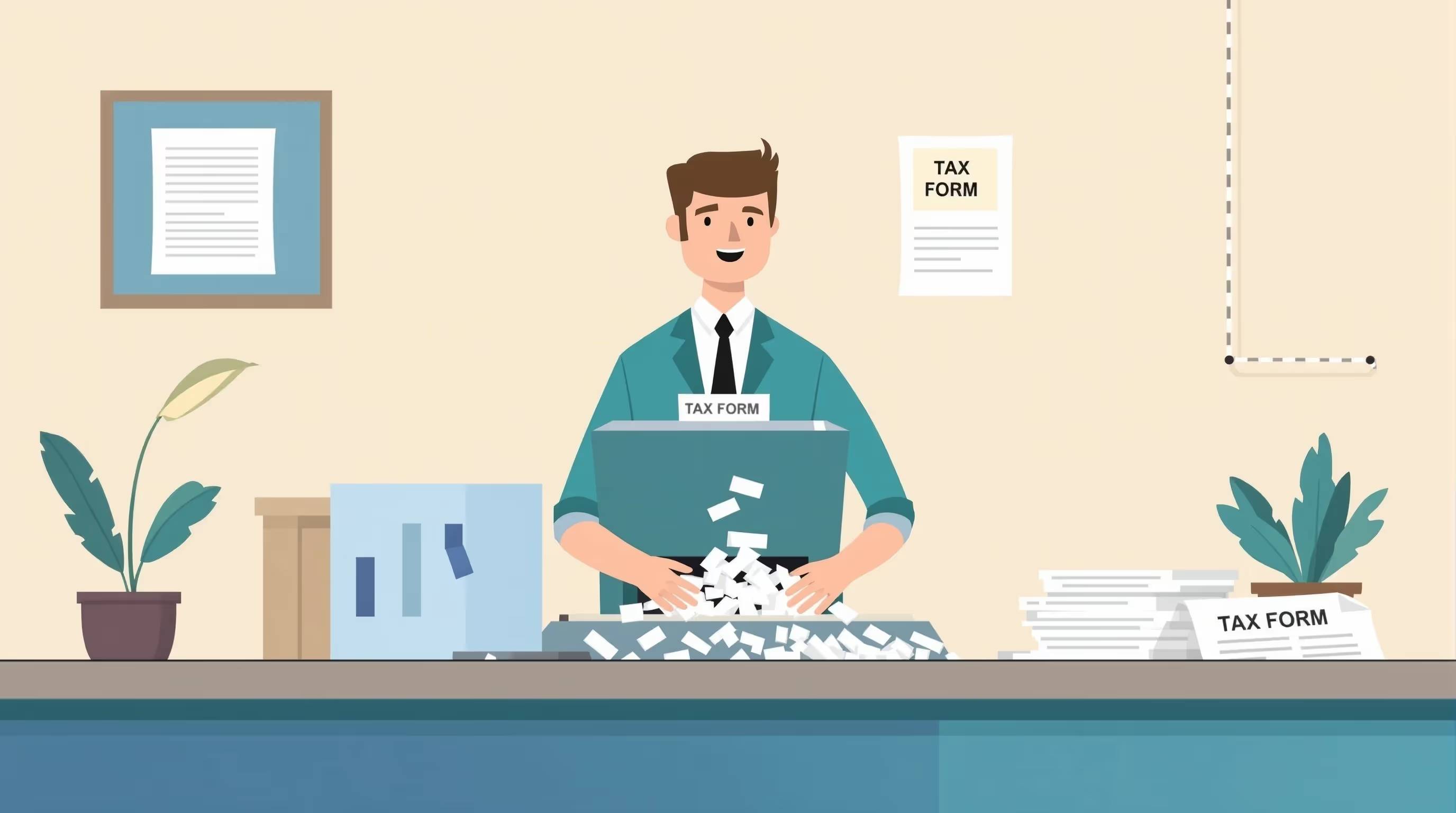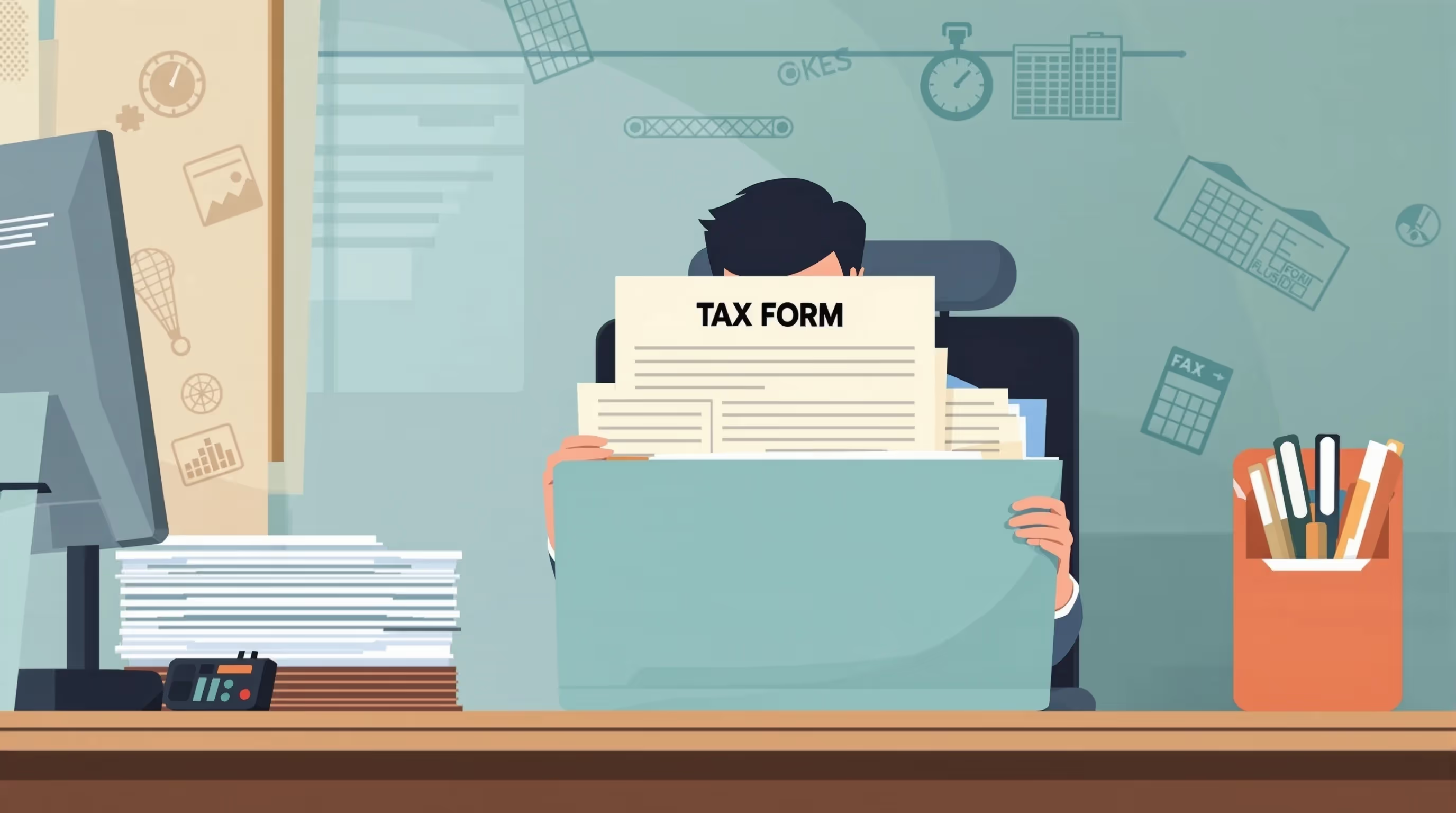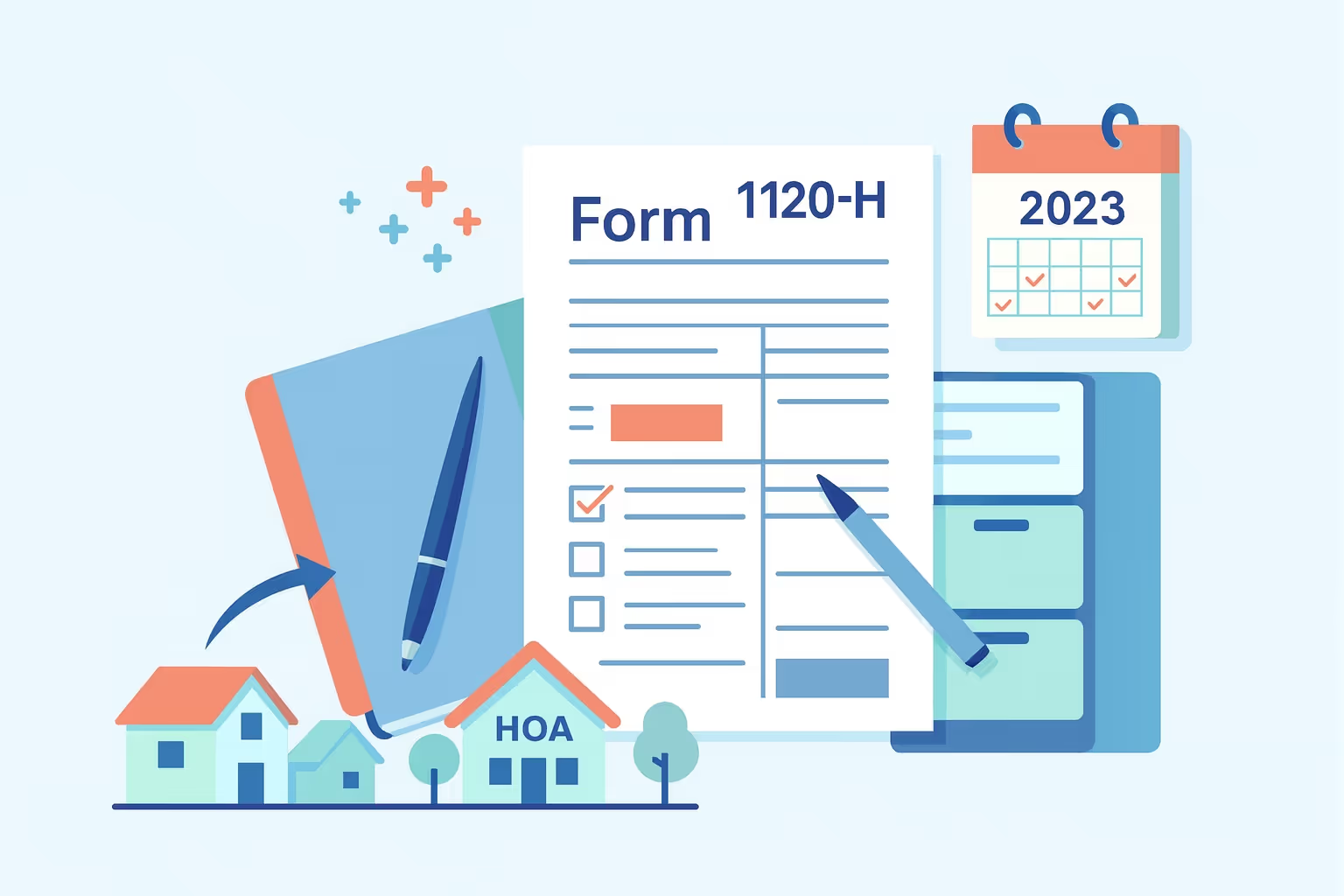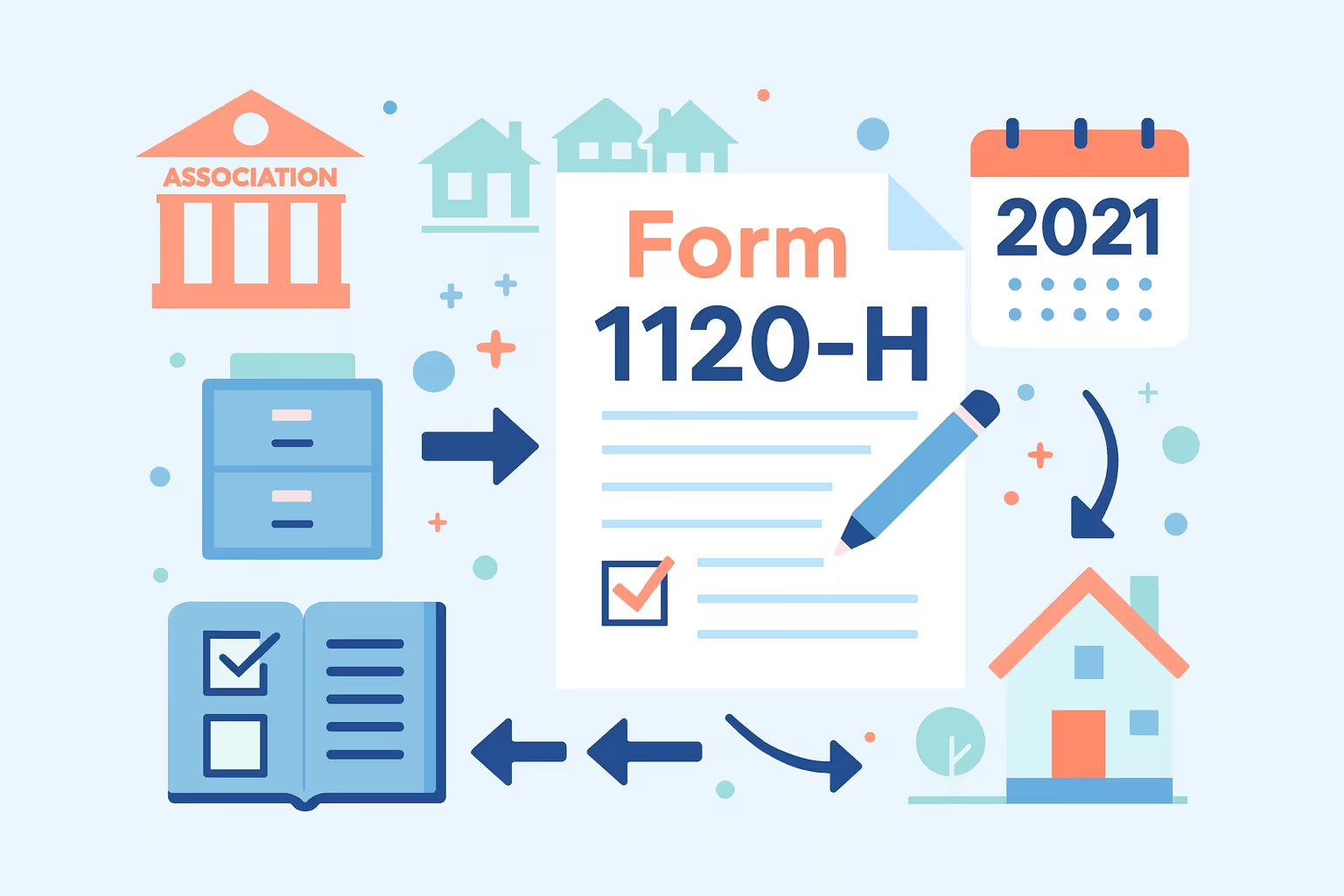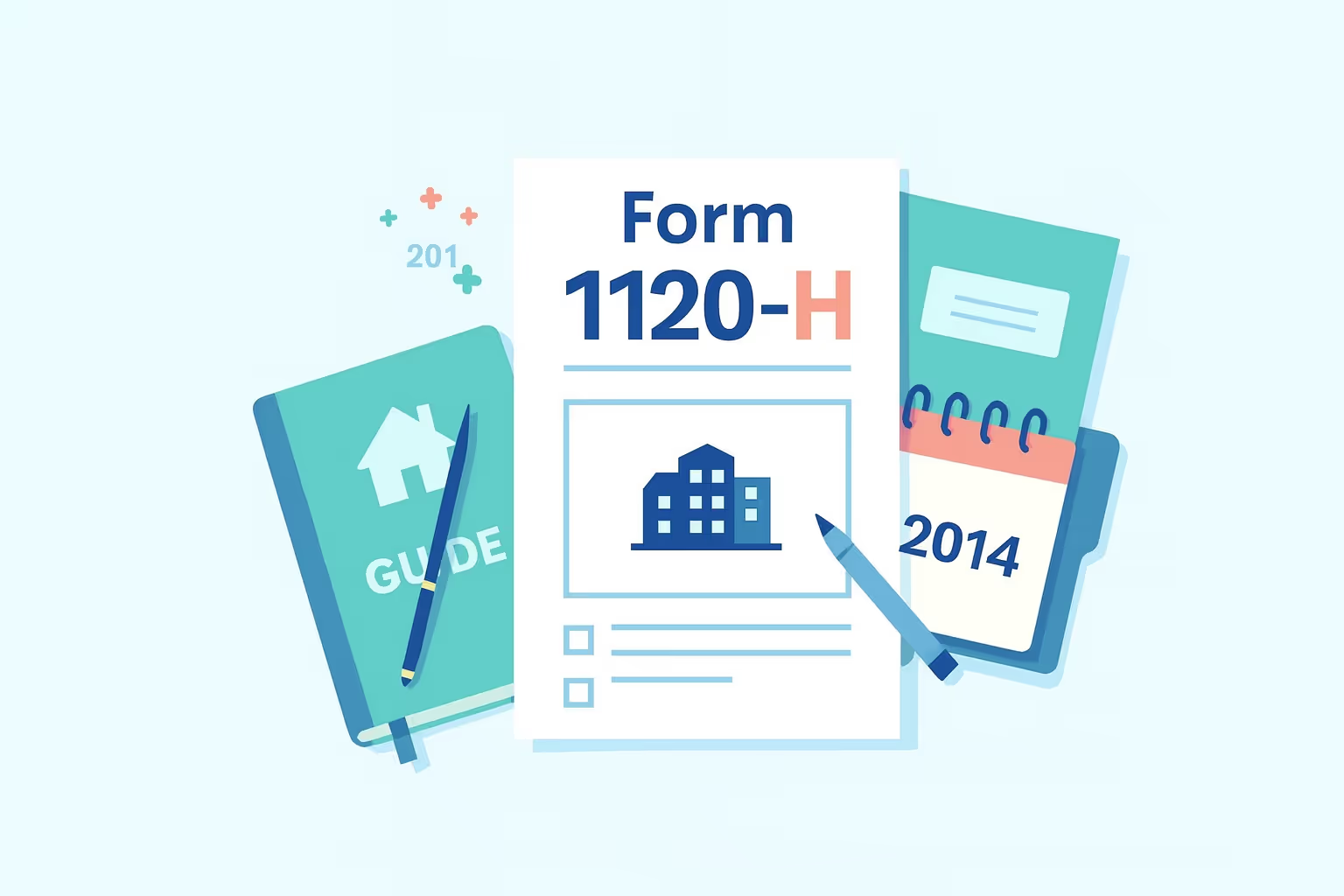Form 1120-H 2018 Instructions: HOA Tax Filing Guide
Form 1120-H is the income tax return used by homeowners' associations to report their annual income and claim certain tax benefits under Internal Revenue Code Section 528. It allows associations to exclude from taxable income exempt function income, such as membership dues, fees, and assessments. This helps associations simplify their tax reporting and focus only on paying tax on investment or non-member income.
For the 2018 tax year, many homeowners' associations needed clear guidance on how to complete their federal forms correctly. The 2018 IRS instructions introduced changes that affected reporting rules, filing addresses, and deductions for interest expenses. Understanding these updates is essential for associations seeking to maintain their tax-exempt status while ensuring compliance with the Internal Revenue Service.
This guide provides step-by-step instructions for filing Form 1120-H for the 2018 tax year. It explains qualification tests, deductible expenses, filing requirements, and payment procedures in plain language. Whether managing a condo association, residential real estate association, or timeshare association, this resource helps association members and paid preparers complete the tax form accurately and on time.
Understanding Form 1120-H
Form 1120-H is the income tax return designed for homeowners' associations that want to take advantage of certain tax benefits under Section 528 of the Internal Revenue Code. It helps these organizations report their gross income, exclude exempt function income, and determine the amount of taxable income subject to federal tax. By using this form, associations can simplify their income tax reporting process and ensure compliance with the Internal Revenue Service.
What Is Form 1120-H?
Form 1120-H allows a qualifying homeowners' association to exclude exempt function income such as membership dues, annual assessments, and fees paid by association members. The association then pays tax only on its remaining taxable income, which usually includes investment returns, rental income from non-members, and other non-exempt sources. This federal form is widely used by condominium associations, residential real estate associations, and timeshare associations that meet the IRS qualification tests.
Benefits of Filing Form 1120-H
Homeowners' associations that qualify to file Form 1120-H can receive several advantages:
- Simplified reporting: Associations can exclude exempt function income and report only taxable income from non-member sources.
- Favorable flat tax rate: Condominium and residential real estate associations pay a flat rate of 30%, while timeshare associations pay a rate of 32%.
- Consistent compliance: Filing the correct tax form is essential to maintaining the association’s tax-exempt status and helps avoid penalties.
- Predictable calculations: The flat tax rate and standard $100 deduction make it easier to calculate the total tax owed.
Qualifying Types of Associations
According to the IRS, three primary types of associations may file Form 1120-H:
- Condominium associations: These are organized to manage, maintain, and care for properties where substantially all residential units are used as homes.
- Residential real estate associations: These oversee developments or subdivisions where most lots or buildings serve as residences for individuals.
- Timeshare associations manage and maintain properties used by members who hold timeshare interests or rights to occupy the property.
Each type of association must ensure its operations and financial activities align with Section 528 rules to qualify for filing.
When used correctly, Form 1120-H allows homeowners' associations to maintain compliance while reducing their taxable income. Filing this form ensures that exempt income, such as dues and assessments from members, remains tax-free, allowing the association to focus its revenue on property maintenance and community services.
What’s New for the 2018 Tax Year?
The 2018 tax year introduced several updates that affected homeowners' associations filing Form 1120-H. These changes clarified certain deductions, adjusted filing procedures, and refined reporting standards set by the Internal Revenue Service. Understanding these updates helps ensure compliance when preparing the income tax return.
Key Changes Introduced in 2018
- The Tax Cuts and Jobs Act added a business interest expense limitation under Section 163(j). Associations with substantial interest expenses may need to complete Form 8990 to calculate the allowable deduction.
- Some filing addresses changed for returns submitted after June 17, 2019. Associations should confirm the correct address listed on the IRS website before mailing their tax form.
- While electronic filing was not required in 2018, the IRS encouraged the use of tax preparation software for faster processing and fewer filing errors.
- Associations continued to be exempt from estimated tax payments and the alternative minimum tax. This reduced the administrative burden for smaller organizations.
These updates made it easier for homeowners' associations to file accurately and adapt to newer IRS procedures while maintaining their tax-exempt status.
Eligibility Requirements for Form 1120-H
Before filing Form 1120-H, an association must confirm that it meets the IRS qualification criteria. These requirements ensure that only legitimate homeowners' associations receive the intended tax benefits.
The 60% Gross Income Test
- At least 60% of the association’s gross income must be derived from exempt function income, such as membership dues, annual assessments, or fees collected from association members.
- Non-member payments and rental income from outsiders cannot be included in exempt function income.
- Associations should document all income sources carefully to support this calculation.
The 90% Expenditure Test
- At least 90% of the association’s expenses must be used for acquiring, building, managing, maintaining, or caring for association property.
- Capital expenditures that improve common areas also count toward this requirement.
- Transfers to reserve funds or investments are not considered qualifying expenditures.
Other Qualification Rules
- No private shareholder or individual may profit from the association’s net income, except through property-related services.
- The election to file Form 1120-H must be made annually and cannot be revoked once made for that tax year.
- Associations that fail either test must instead file Form 1120, which taxes all income at corporate rates.
Meeting these eligibility requirements ensures the association can exclude exempt function income and continue to benefit from the simplified flat tax rate structure.
Step-by-Step Instructions for Completing Form 1120-H
Filing Form 1120-H correctly is essential to ensure compliance with IRS requirements and to calculate the correct tax paid. Associations should follow a structured process to accurately report income, deductions, and total tax.
Step 1 – Gather Required Information.
Before completing the form, associations should prepare the following:
- The Employer Identification Number, or EIN
- Financial statements showing income, expenses, and total expenditures
- Bank and investment statements for interest income and capital gains
- Records of assessments, membership dues, and fees collected
- Any prior-year tax return or amended return, if applicable
Step 2 – Fill Out Header Information.
- Enter the association’s legal name, address, and EIN exactly as registered.
- Indicate the applicable tax year, whether calendar year or fiscal year.
- Select the correct association type from the following options: condominium, residential real estate, or timeshare.
- Mark any special status such as final return, name change, or address change.
Step 3 – Complete Items A through E.
- Identify the type of return being filed and confirm qualification under the 60% income and 90% expenditure tests.
- Report total expenditures and tax-exempt interest received during the year.
- Ensure figures are rounded to whole dollars and supported by records.
Step 4 – Report Income (Lines 1–8).
- Include only taxable income such as dividends, interest income, rental income from non-members, and capital gains.
- Exempt function income should not be included here, as it is excluded from taxable income.
- Summarize all non-exempt income to determine the total gross income subject to tax.
Step 5 – Enter Deductions (Lines 9–18).
- Deductible expenses must relate directly to generating taxable income. Examples include professional fees, interest on loans, repairs, or depreciation.
- Claim the standard $100 deduction allowed for all associations.
- Expenditures related solely to exempt functions cannot be deducted here.
Step 6 – Calculate Tax (Lines 19–22).
- Subtract total deductions from gross income to determine taxable income.
- Apply the correct flat rate: 30% for condominium and residential real estate associations or 32% for timeshare associations.
- Subtract any tax credits to determine the total tax due.
Step 7 – Sign and Attach Required Documents.
- Attach schedules and forms as required, including Schedule D, Form 4562, Form 4797, or Form 8990 if applicable.
- Ensure an authorized association officer or a paid preparer signs the return.
- Review all calculations before submitting to avoid processing delays.
Completing these steps carefully ensures that the homeowners' association correctly reports its income and qualifies for the tax benefits available through Form 1120-H.
Filing Instructions for Form 1120-H
Once the form is completed, homeowners' associations must ensure it is filed correctly and on time. Filing accurately and meeting deadlines preserves the right to exclude exempt function income and simplifies future reporting.
Filing Deadlines
- For associations using the calendar year, the due date for the 2018 tax year was April 15, 2019.
- Fiscal year filers must submit their return by the 15th day of the fourth month after the close of their fiscal year.
- If the due date falls on a weekend or legal holiday, the form can be filed on the next business day.
- Filing after the deadline may result in penalties and loss of the Form 1120-H election for that year.
Where and How to File?
- Paper filers must send their return to the correct IRS service center based on the association’s location.
- Associations may also use electronic filing for faster processing and confirmation of receipt.
- The IRS website lists updated mailing addresses for each region.
- Before mailing, confirm that the form is complete, signed, and includes all required attachments.
Extension Requests
- Associations needing extra time to prepare their income tax return can submit Form 7004 to request an automatic six-month extension.
- Form 7004 must be filed by the original due date of the return.
- The extension only applies to filing, not to payment of taxes owed.
- Any tax due should be paid by the original due date to avoid penalties and interest.
Proper filing ensures that the Internal Revenue Service processes the return efficiently and maintains the association’s tax-exempt status for the given year.
Payment and Compliance Guidelines
After filing Form 1120-H, the association must pay any tax owed and follow compliance procedures established by the IRS. Paying electronically helps prevent delays and ensures prompt payment recording.
Payment Methods
- Associations must use the Electronic Federal Tax Payment System (EFTPS) to make federal tax payments.
- EFTPS allows payments to be scheduled online or by phone.
- Transactions should be submitted by 8 p.m. Eastern Time on the day before the payment due date.
- Same-day wire transfers are available for associations that miss the EFTPS cutoff.
Installment Agreements
- Associations unable to pay the full amount immediately may qualify for an installment plan.
- Eligibility typically requires a total balance of $25,000 or less.
- Payment terms generally extend up to 24 months.
- Associations must continue to file timely tax returns and payments during the agreement period.
Penalties and Interest
- Late payments may result in penalties of 0.5% per month, up to 25% of the unpaid balance.
- Interest is charged from the original due date until the tax is paid in full.
- Filing the income tax return on time, even without payment, may reduce penalty charges.
Following these payment and compliance rules helps ensure that the total tax paid is processed accurately and that the association remains in good standing with the Internal Revenue Service.
Common Mistakes to Avoid
Even minor errors can result in penalties or the loss of tax benefits. Reviewing the return carefully helps homeowners' associations avoid unnecessary problems.
Frequent Errors When Filing
- Reporting exempt function income as taxable income on Lines 1 through 8 instead of excluding it.
- Misclassifying expenses that do not relate to producing taxable income as deductible expenses.
- Using incorrect tax rates instead of the flat rate specified for the association type.
- Forgetting to claim the $100 deduction or omitting the association’s EIN.
- Submitting the return without a valid signature from an authorized officer or paid preparer.
- Filing after the due date and losing eligibility to elect Form 1120-H for that tax year.
How to Prevent Filing Errors?
- Keep detailed records of all income, expenditures, and assessments collected from members and non-members.
- Review qualification tests before filing to confirm the association meets both the 60% income and 90% expenditure rules.
- Compare the tax due on Form 1120-H with the tax due on Form 1120 to determine which option results in the lowest tax liability.
- Use tax preparation software or consult a professional preparer for complex returns.
Careful preparation helps ensure the return is accurate, supports the exclusion of exempt function income, and maintains compliance with IRS filing requirements.
Filing in a Zero-Activity or Dormant Year
Some homeowners' associations may have little or no financial activity during a given year. Even in these cases, filing Form 1120-H can help preserve the association’s ability to claim tax benefits in the future.
When to File in a Dormant Year?
- Associations should file even if they had no taxable income, as long as they wish to maintain their election under Section 528.
- Filing establishes a consistent record of compliance with the Internal Revenue Service.
- Submitting a return also prevents confusion about the association’s tax-exempt status.
How to Complete Form 1120-H with Zero Activity?
- Enter the association’s legal name, address, EIN, and tax year information in the header.
- Report exempt function income, such as membership dues or assessments, even if this was the only revenue received.
- Enter zero for all other income, deductions, and taxable income if no non-member revenue was earned.
- Claim the standard $100 deduction and calculate the total tax owed, which will generally be zero.
When Filing May Not Be Required
- If an association received only exempt function income and does not wish to maintain its Form 1120-H election, filing may be optional.
- Choosing not to file, however, may result in the need to use Form 1120 in future years and can trigger questions from the IRS.
Filing even during inactive years is a good practice that helps maintain the association’s eligibility for simplified tax treatment and supports transparent reporting.
First-Time Filer Tips
Newly formed homeowners' associations often face confusion when completing their first income tax return. Following a few key steps makes the process easier and helps ensure compliance.
Getting Started
- Obtain an Employer Identification Number from the IRS before filing.
- Keep organized records such as meeting minutes, financial statements, and proof of assessments collected.
- Review the IRS Form 1120-H instructions to understand what qualifies as exempt function income and what counts as taxable income.
Making the Election to File Form 1120-H
- Compare Form 1120-H with Form 1120 to determine which provides the lower overall tax liability.
- File Form 1120-H annually if it offers a better result, since the election applies only for that tax year.
- Ensure that all qualification tests are met before making the election to avoid rejection.
When to Seek Professional Help
- Associations with mixed income sources or complex investments should consider hiring a professional tax preparer.
- Professional assistance is especially valuable when dealing with non-member income, interest income, or capital gains.
- Experienced preparers can also help identify deductible expenses and apply available tax credits.
Taking time to understand the filing process early ensures that future returns are accurate and that the association maintains its tax-exempt benefits consistently.
Frequently Asked Questions
What are the main benefits of filing Form 1120-H for homeowners' associations?
Filing Form 1120-H allows homeowners' associations to exclude exempt function income, such as membership dues, annual assessments, and fees collected from association members. This helps reduce taxable income and ensures that only non-member income, such as interest income and capital gains, is taxed at a flat tax rate. These tax benefits make the income tax return process simpler and more efficient for qualifying associations.
How does Form 1120-H calculate taxable income for a given tax year?
Form 1120-H determines taxable income by subtracting deductible expenses from gross income that does not qualify as exempt income. Only non-member revenue, such as rental income or interest from investments, is subject to income tax. The total tax is then calculated using the flat rate of 30% for residential real estate associations and condo associations, or 32% for timeshare associations.
What are the filing requirements for Form 1120-H?
Homeowners' associations must file Form 1120-H each calendar year if they wish to elect tax-exempt status under Section 528 of the Internal Revenue Code. The income tax return must include accurate figures for total expenditures, gross income, and deductions. The due date is the 15th day of the fourth month after the end of the association’s tax year.
What types of income should be reported on Form 1120-H?
Associations must report only taxable income that is not considered exempt function income. This includes interest income, dividends, rental income from non-members, capital gains, and other income from business activities. Exempt income from membership dues or assessments should be excluded from the calculation. Reporting taxable and exempt income correctly ensures compliance with Internal Revenue Service rules.
Are estimated tax payments required for associations filing Form 1120-H?
No, associations filing Form 1120-H are not required to make estimated tax payments. Any tax owed must be paid in full by the due date of the income tax return. The Internal Revenue Service waives this requirement for qualifying condominium associations, residential real estate associations, and timeshare associations that elect to file under Section 528.
Can an association file an amended return for Form 1120-H?
Yes, if an error is discovered after filing, an association may file an amended return for the same tax year. The amended form should clearly explain the reason for the correction and include any changes to income, deductions, or tax credits. Filing an amended return promptly helps avoid penalties and ensures accurate reporting with the IRS.
When should homeowners' associations seek professional tax help?
Associations should consult a paid preparer or use reliable tax preparation software when dealing with complex income sources or multiple properties associated with the organization. A professional can help identify deductible expenses, calculate total tax correctly, and ensure that all filing requirements are met. This support is beneficial for large associations with significant revenue or non-exempt income.






